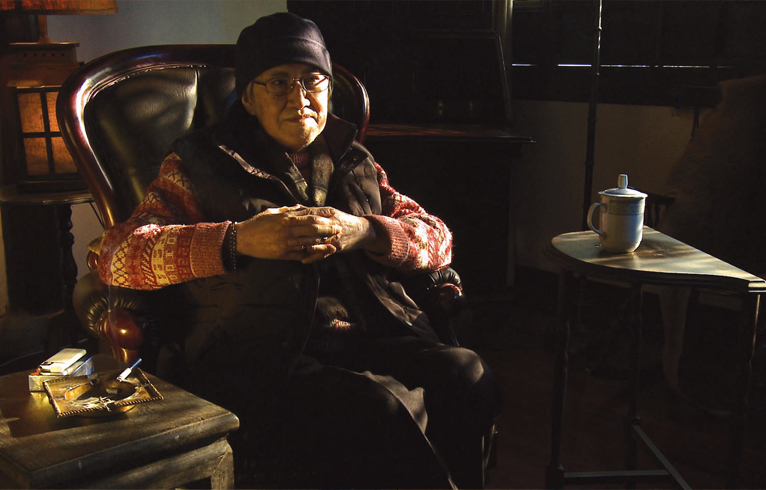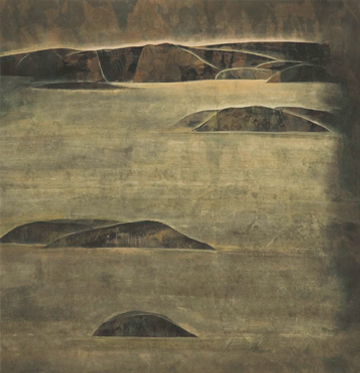OUR TIME WITH MU XIN
| April 19, 2012 | Post In LEAP 13

MU XIN, WHOM we had the good fortune of meeting and interviewing in December 2010, was one of the world’s greatest artists. He made a profound impact on anyone who had such good fortune. For many others, who knew him through his writings and art, his impact was equally as powerful. Throughout his creative life, he chose to keep a distance from his audience. He was a lifelong adherent to Flaubert’s credo “Reveal the art, conceal the artist.”
Our road to Mu Xin was a circuitous one. In 2008 we started development on a documentary film based on portraits of living Chinese artists. For two years we went through the fundraising process of drafting proposals, meeting potential donors, and knocking on the doors of cultural institutions, but with no luck. We were about to give up when our research brought us to Mu Xin.
Here was a man who had lived through China’s pre- and post-revolutionary periods, who had risked his life to create his incredible “Prison Notes” and “Landscape Paintings” while imprisoned during the 1970s. Experts were calling him a living link between classical and modern Chinese art, as well as between the East and the West. We learned that he was living in Queens, a borough of New York City. Here was an ideal subject, and he was nearby. Most important to us, though, was the work itself. A small online reproduction of his landscape painting Spring Brilliance at Kuaiji was the first piece of his we saw. Here was a world lost in the immensity of time with its misty, blurred mountains looming triumphant over the minuscule buildings in the foreground. The perilous balance between abstraction and figuration felt like a memory willed onto paper, speaking directly to the heart and the mind. And then we learned of his “Prison Notes,” in which his eloquent, probing intelligence created imagined dialogues with the great thinkers of history.

Through his friends in the United States, Alexandra Munroe— who with the art historian Wu Hung and Munroe’s husband Robert Rosenkranz fearlessly curated Mu Xin’s 2003 traveling exhibition of his work here in the United States— and Toming Jun Liu, a translator and scholar of Mu Xin’s work, we found out that he had left the United States and was now living back in his hometown of Wuzhen. Through his old friend and tireless advocate Chen Danqing we arranged to go there and meet Mu Xin in person, after months of attempts to reach him.
Chen Danqing would come with us and make the introduction. If Mu Xin liked and trusted us, then yes, he would agree to be filmed. If not, we would leave empty handed. We prepared for the worst— apparently Mu Xin hated interviews, and when he did grant them, we were told he could be irascible and impatient. He was known to answer obliquely or not at all when people wanted him to talk about his past, especially his imprisonment. For Mu Xin to talk about this was to give people the ammunition to brand him a “victim artist,” which he was anything but. According to Mu Xin, “The value of art lies in the work of art itself. How or why the work of art was created is less than important.”
It was clear we needed to bring a gift to show our sincerity and respect and establish the intimate rapport needed. We were only going to be in China for a little over a week and every minute counted. We had heard of his love for Western classical music so we came to his door with a boxed set of Beethoven’s Complete String Quartets in our camera bag. When we met he said, “Hello,” quietly, and we were led into his sitting room. We sat across from each other as he surveyed us. He had a wool hat pulled over his forehead and his face was completely still. Only his piercing eyes moved ever so slightly as he squinted at us from behind his thick glasses. He was clearly not one to suffer fools. We quickly fumbled our intentions for the film through our translator: It was going to be a portrait of him. No response. Strike one. “Tell him that our film is going to be a portrait of him but in his own words.” He listened to the translator, lit up a cigarette and shrugged. Was this a yes? Or was this strike two? We then gave him the Beethoven CD set and his face rippled into a smile. He rattled off a few broken sentences. “He’s amazed that you came all the way across the world to bring him Beethoven,” she told us. “Now he wants to know what do you want to talk about?” We looked over at Mu Xin. He was leaning forward in his chair, still smiling. We had passed the test, and as Chen Danqing and Mu Xin reminisced, we set up our lights and camera.

We spent the next six days interviewing him little by little, accommodating the frequent breaks Mu Xin required to collect his breath and his thoughts. Unlike what we had heard, he was lively and jovial, darting from subject to subject, and drawing freely from the literary and artistic traditions of both the East and West, of both ancient and modern times, with incredible ease. What came through, without arrogance or airs, was that he was in constant dialogue with Leonardo da Vinci, Li Yu, Max Ernst, Mi Fu, Tolstoy, Nietzsche and Anselm Kiefer, among others, not as a disciple but as an equal. This was a heady brew, punctuated by a sly, playful sense of humor. After a particularly lengthy discourse on music, he smiled and said, “You came looking for a poet. There’s only an old man here now.”
And his past? He told us about his terrible experiences in prison, his leaving China in the late 1970s for New York, where he struggled for over 30 years. He told us he had only exhibited his works twice in the United States, his 2003 show happening when he was already 73 years old. He told us how he waited over 30 years to be published in China, and of his final return to live there when he was already 76. All of this was told without a trace of bitterness. They were just facts, recounted as if it all happened to someone else long ago, as if it had nothing to do with his work. As he told us, “What’s important is the work I am doing now.”
In his pristine studio he showed us the paintings that he had been working on over the last few years. It was another series of incredible landscapes in miniature that, along with the walls of books he had written since the 1980s that lined his study, were solid proof that he was always working and keeping true to his word to, as he told us, “be worthy of the promise I made to art as a young man.”
When we said goodbye, it was unsaid but understood that, at his age, this might very well be his last interview. The fact that it was gives the footage an added poignancy, because he was so alive when we visited him. His face was unlined, showing no signs of his age, his eyes completely clear and his mind alive with spirit and ideas.
We hope that our film introduces more people to this great artist who taught us from the shadows how to lead our lives in the face of adversity. He showed us that what you say means little, but what you do with your time on this earth is everything. He will be greatly missed.
(Ed. note: At the time of print, the documentary film based on the interview in question was still in post-production.)

